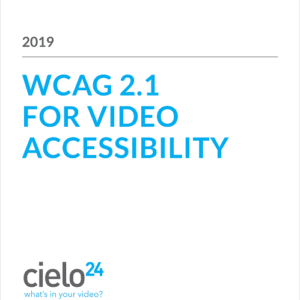EU Web Accessibility Laws and Policies There are 3 main EU web accessibility laws and…

Guide to Canadian Web Accessibility Laws and Policies
Canadian Web Accessibility Laws and Policies
There are various laws and policies that support web accessibility in Canada. Current legislation does not require accessibility across all organizations, but a new Canadian web accessibility law is in the planning stages.
Canadian Human Rights Act of 1977
The Canadian Human Rights Act was created to ensure that all individuals have equal opportunities in life and are free from discrimination based on “race, national or ethnic origin, colour, religion, age, sex, sexual orientation, marital status, family status, disability….”
It has been interpreted that this covers website accessibility, as inaccessible websites bar people with disabilities from accessing and benefiting from online information, goods, and services.
Even though this law was written before the emergence of the internet, the case can be made that inaccessible web content prevents people with disabilities from having equal opportunities “to make for themselves the lives that they are able and wish to have and to have their needs accommodated…without being hindered in or prevented from doing so by discriminatory practices.”
Policy on the Duty to Accommodate Persons with Disabilities in the Federal Public Service
This policy supports Canadian web accessibility by requiring the federal Public Service to “ensure that all employment opportunities are advertised in an accessible format” and that they “create and maintain an inclusive, barrier-free work environment that is accessible.”
The policy aims to ensure the full participation of people with disabilities in the federal Public Service, whether as applicants or employees. A barrier-free and accessible work environment is to be created by:
- Identifying and removing barriers to employment, career development, and promotion of persons with disabilities unless doing so would result in undue hardship
- Designing all employment systems, processes, and facilities to be accessible by building accommodation into workplace standards, systems, processes and facilities
- Accommodating individuals when such barriers cannot be removed. Such accommodation must be made to the point of undue hardship taking into consideration issues of health, safety, and cost. Accommodation must also be based on the circumstances of each case and must respect an individual’s right to privacy and confidentiality.
Standard on Web Accessibility

The Standard on Web Accessibility was created in 2011 to ensure a that a high level of Web accessibility is applied uniformly across Government of Canada websites and Web applications. cielo24 has updated 2019 WCAG 2.1 guidelines available here.
The Standard requires government web pages to meet all five of the WCAG 2.0 conformance requirements, including Level AA conformance. The five conformance requirements include:
- Conformance level: Level AA in full. Requirements include synchronous captions for all multimedia. View the guidelines here.
- Full pages: Conformance cannot be achieved if part of a web page is excluded.
- Complete processes: When a web page is one of a series of web pages presenting a process (i.e., a sequence of steps that need to be completed in order to accomplish an activity), all web pages in the process must conform at the specified level or better.
- Only Accessibility-Supported Ways of Using Technologies: Any information or functionality that is provided in a way that is not accessibility supported must also be available in a way that is accessibility supported.
- Non-Interference: Technologies that are not relied upon by a user and are not accessibility supported can be used if they do not interfere with access to the rest of the page.
Canada Web Accessibility
In June of 2016, Carla Qualtrough, the Minister of Sport and Persons with Disabilities, announced the launch of a national consultation process to inform the development of planned legislation that will transform how the Government of Canada addresses accessibility. The consultation process will address how Canada can overcome barriers such as:
- Physical, architectural and electronic barriers that impact the ability of people with disabilities to move freely in the built environment, to use public transportation or to access information or use technology
- Attitudes, beliefs, and misconceptions that some people may have about people with disabilities and what they can and cannot do
- Outdated policies and practices that do not take into account the varying abilities and disabilities that people may have
Canadians are able to give their input until February 2017. They can participate in the creation of this Canadian web accessibility law by visiting Canada.ca/Accessible-Canada and are encouraged to follow the movement on social media. Input on the planned legislation can include:
- Feedback on the overall goal and approach
- To whom would apply
- What accessibility issues and barriers it could address
- How it could be monitored and enforced
- What else the Government of Canada could do to improve accessibility
In addition to this consultation process, the Qualtrough has also announced that the Government of Canada has begun a consultation process on Canada’s accession to the United Nations Optional Protocol to the Convention on the Rights of Persons with Disabilities (the Optional Protocol).
Canada ratified the United Nations Convention on the Rights of Persons with Disabilities in 2010. Now the Government of Canada is looking to adopt the Optional Protocol to further the rights of Canadians with disabilities. The Optional Protocol:
gives people with disabilities a new safeguard for their rights by establishing two procedures aimed at strengthening the implementation and monitoring of the convention. The first is a complaint procedure that allows individuals and groups to bring petitions to the Committee on the Rights of Persons with Disabilities claiming that their rights under the convention have been violated. The second is an inquiry procedure that gives the Committee authority to investigate allegations of grave or systematic violations of the provisions of the convention by a state party.
Conclusion
An analysis of data from the 2012 Canadian Survey on Disability found that approximately 2.1 million Canadians aged 15 years or older are at risk of facing barriers in the built environment and/or in relation to information and communications.
The upcoming Canadian web accessibility law will greatly help reduce these barriers and create a more accessible Canada for all citizens. Stay tuned for any updates to the coming legislation.



